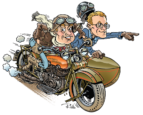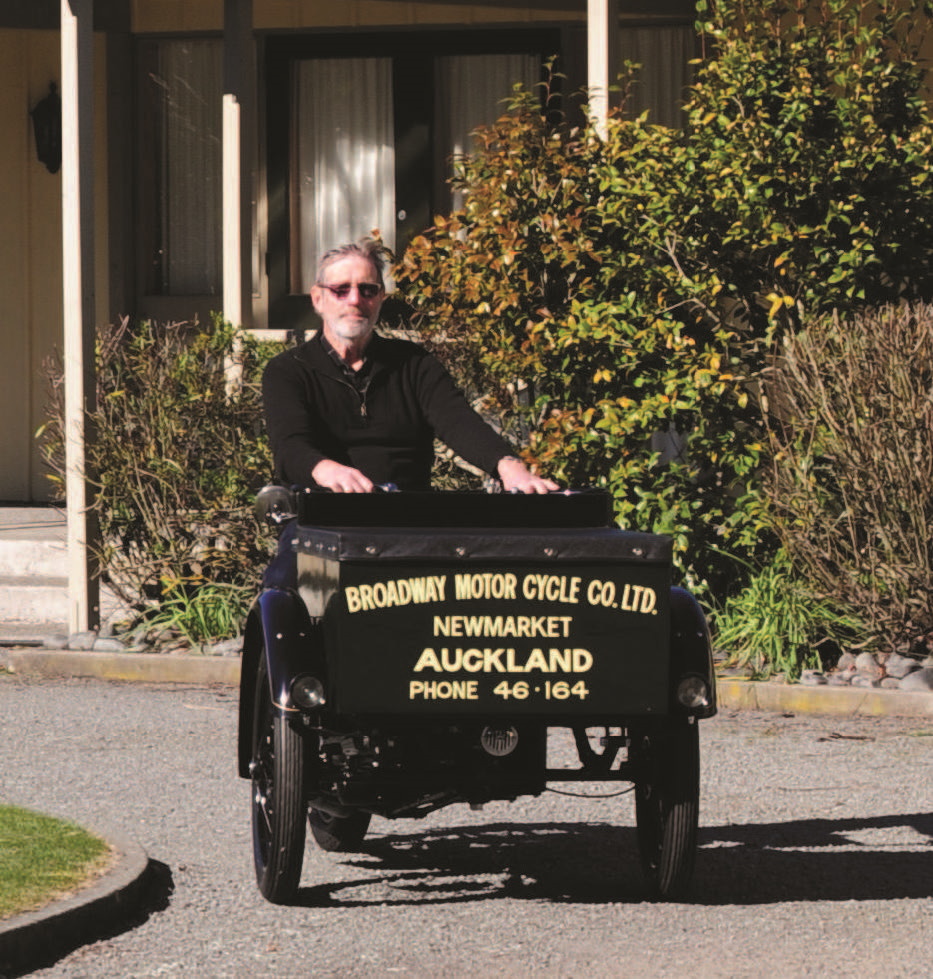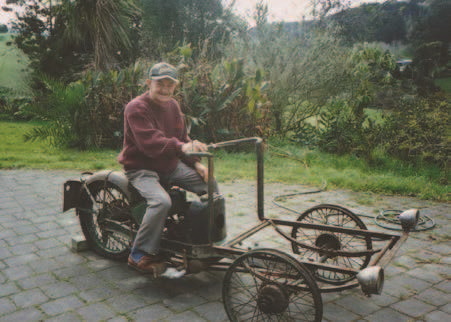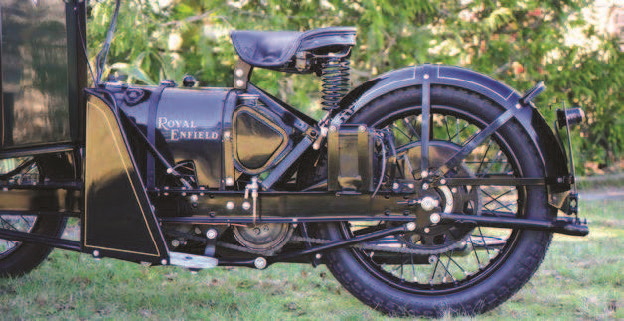In the October/November 2019 issue of the Vintage Car Clubs bi-monthly magazine, Beaded Wheels, there is an excellent article by Bevars Binnie about a 1935 Royal Enfield Motor Carrier. This article ,and associated pictures, prompted us to ask Bevars if we could reproduce this here at Barnstormers, as its is a unique machine worthy of wider attention. With permission granted and a thanks to the VCCNZ for kindly letting us reproduce this, here is the article, unabridged for your enjoyment.
It’s strange how things happen. I casually mention to Editor Kevin (VCCNZ) that if he wanted a Behind the Wheel article about an early motorcycle then I might be persuaded to write one some time in the future, although that would make it a Behind the Handlebar article I suppose. So here I am writing about Jens Christensen’s 1935 Royal Enfield Motor Carrier less than a month later.
I have owned and/or ridden well over 100 Veteran, Vintage and Post Vintage motorcycles, including a couple of dozen single cylinder and v-twin Royal Enfields. All of these have been different to ride, but generally a pre WWII bike will fall into one of a few simple categories. These are the pre 1910 early primitive types, the later and more capable Veterans, the competent and more reliable Vintage and the post 1930 bikes which are similar to early post WWII bikes, but with girder forks. Add in British, American and Continental differences and you have most early bikes covered. But the subject of this article is something else entirely and falls into none of these categories, even though the large and famous Royal Enfield motorcycle firm made it and used mostly motorcycle components.
Royal Enfield History
But before we get to the vehicle itself here is a little history. The roots of Royal Enfield can be traced back to the 1840s and the manufacture of sewing needles by George Townsend and Company. By the 1860s they were also making precision light machine parts, and in the late 1880s had added bicycles to their range. In 1892 the business was taken over by Bob Walker Smith and Albert Eadie, who re-registered it as the Eadie Manufacturing Co Ltd. They soon received a contract to supply rifle parts to the Royal Small Arms Factory at Enfield so formed a new company called the Enfield Manufacturing Company and started marketing some bicycles under the Royal Enfield brand. Around this time they adopted a field gun as their trademark and the advertising slogan “Made Like a Gun”. Despite this they apparently never made guns, just gun parts. The company had a couple of further name changes, but in 1898 it finally settled down as the Enfield Cycle Company, under which name it continued to trade for more than 70 years.
In 1898 Enfield started producing quadricycles, and over the next few years made tricycles and motorcycles as well. In 1902 they added the Enfield car to their range. This part of the business was put into a separate company called the Enfield Autocar Company Limited in 1906. Unfortunately it suffered early losses and was sold to Alldays & Onions in 1908. In 905 the motorcycle market was suffering from oversupply and the company made the decision to stop making motorcycles.
In 1909 Enfield re-entered the motorcycle market and over the next few years they developed a range of v-twins with the smallest being some 300cc and the largest 770cc. A 2-stroke model was added just before WWI and single cylinder 4 stroke models were added in the mid 1920s, but the company still had a relatively small range of models until the late ‘20s. While most of the bikes were relatively conservative designs, Enfield did make some innovations, inventing the cush drive hub in 1912 in a form that is still used on many motorcycles today. They introduced one of the first dry sump engines on the 3hp 425cc machine, also in 1912. This had a glass oil tank behind the seat downtube – glass so that the sceptical owner could see the oil going round and round. Over the years Enfields were raced extensively with considerable success at the Isle of Man TT and at Brooklands, but their reputation was really for high quality, rugged and reliable machines and parts. Their two speed countershaft gear was used by a number of motorcycle manufacturers in the late teens and early ‘20s, while Brough Superior and Norton among others used their hubs and brakes.
By the late ‘20s Enfield was doing what other manufacturers were doing and made a wide range of models in the hope of having “something for everyone”. Hindsight suggests that doing t the start of the Great Depression was not a winning formula, but RE managed to survive until many years later.

Evidently it was nicknamed |
 |
In 1935 while the Great Depression was still a major problem Enfield decided to make a Motor Carrier – the subject of this article. From the 1900s carrier bicycles had been made in England as a cheap means of delivering small loads of goods of all sorts. They carried goods in a basket, box or cage arranged somewhere on the bike, but generally over the front wheel or wheels. Many of us who are a bit older will remember these from our childhood, as they were popular with butchers and grocers. Most of these were two wheeled bicycles, but three wheelers with a box over a two-wheeled front end were used for heavier loads. It was a natural progression to fit a motor to a larger version of this, and these became know as Motor Carriers.
Enfield’s Motor Carrier has a substantial pressed steel channel chassis, with a single rear wheel and a two wheeled front axle, which pivots in a single central “king pin”. A largish cargo box is attached to the axle by leaf springs and turns with the axle. A 225cc 2-stroke motor, as fitted to Enfield’s Model A motorcycle, is used and drives through a 3-speed gearbox. The engine is enclosed under a cover and fins on the external flywheel provide cooling as the box at the front blocks any airflow from reaching the engine. Overall gearing is low, giving a claimed top speed of 25 mph and the whole outfit has a substantial look and feel. The clutch, back wheel and foot operated rear brake are larger than might be expected and appear to be the same as fitted to their larger motorcycles, probably in recognition of the total weight when the box is fully loaded. Both front wheels have brakes fitted and these must be carefully adjusted, as any imbalance will cause an unexpected sharp turn to be executed. There is also a handbrake lever to hold the outfit stationary when being loaded or unloaded.
A handlebar is fitted to the rear of the cargo box with throttle and clutch levers fitted to it. The whole box and front axle has to turn to steer the outfit. It has electric lights, with a battery, a coil and a generator that has the ignition points mounted on the end of it.
The basic Motor Carrier cost £45 in England, and a range of different cargo boxes was available, with the smallest costing £2 and a special box designed to hold eight crates of 16 pint bottles of milk costing £10. Enfield claimed that it “could climb any main road hill with a full load” but I am not sure they realised just how much some people would load into the box.
Enfield evidently had about 250 chassis made, but it is not clear how many machines were completed. Some chassis were evidently sold to the Dot Motorcycle Company, and an unknown number were scrapped. Only four are known to survive world wide, with the last of these having come to light in the last couple of years.
Jens purchased his Motor Carrier from Auckland member Peter Alderdice in 2009, Peter having owned it since the early 1990s. It was originally despatched from the factory as a “chassis complete, less body” and sent to a UK export company called Scholefield-Goodman in Birmingham. It was imported new by Broadway Motors, Enfield dealers of Newmarket Auckland, who used it to pick up and deliver parts and spares.
When Peter bought the Motor Carrier it was more or less complete but dismantled for restoration and missing a few parts, most of which were unique to the bike. Peter made contact with George Hughes who was an apprentice motorcycle mechanic at Broadway Motors in the early 1940s and who rode the beast at that time. Evidently it was nicknamed “The Crab”, perhaps a reference to its looks or maybe to its handling?
Peter chased around the world to find out what he had bought and to find information about it. He very quickly found that it was a rare vehicle and that no one knew anything much about it. He re-assembled the machine and started restoration, including building a new box, but it still needed complete restoration when Jens bought it. Phillip Jeeves restored it for him, rebuilding where needed and making missing parts when originals couldn’t be found. Its oddball looks along with its excellent paint and plating means it is a delight to look at.
Initially a correct original carb was elusive and the motor did not run all that well on the substitute fitted and it would not pull top gear. A visit by Jens to Modak in Elizabeth Street in Melbourne produced the correct carb, with the owner commenting that he “had always wondered what that was off”. With this fitted the motor runs sweetly and it will now pull top gear.
Road Test
I approached this by discarding all thoughts of riding a conventional motorcycle, but I did think it might be a little like riding a sidecar outfit. Only it didn’t turn out to be like that either. It really was a unique experience.
As the outfit is not currently registered the test ride was done at the Canterbury Branch grounds at McLeans Island, which has the dual advantages of being flat and devoid of other traffic.
The motor starts on the second or third prod of the kick-start and you can climb on board from either side. The handlebar feels strange as it is attached to the box at each end and is curved towards the rider, which means that you have to swing the bars from side to side rather than turning them. It also means that instead of your hands falling naturally onto handgrips you have to choose a spot on the bar to grab and your hands are unnaturally twisted inwards. My aging arthritic thumbs were feeling the strain after only a short ride. Both feet fit into leg-shields, which would give some protection in wet weather. The foot brake pedal is at the front of the right one.
Pull the clutch lever in, select first gear, engage the clutch and off we go. The gearing is so low that no extra throttle was needed to get underway on the flat ground and I was able to take my time to get used riding it. My first priority was to try the steering and I was surprised to find how light and precise it was. I have to admit to being apprehensive as the first time I set eyes on the beastie some 12 months ago as Jens had tipped it on its side at low speed because of some over enthusiastic cornering. This was in front of a few enthusiasts gathered at the Social Corner at McLeans Island so he got a hearty round of applause, cheering and ribald comment. I was not eager to repeat the feat in front of Jens! If you saw the episode of Top Gear where Jeremy Clarkson drove a 3-wheeled Reliant and repeatedly fell over then you have the idea.
With the steering under control I opened the throttle and then changed into second gear, heading along the driveway towards the gate to get a feel for the beast at speed. With the low gearing acceleration was brisk with the uneven bits of the driveway occasionally causing some bump steering. The sprung saddle absorbed the bumps for the rider and it felt as though it would be comfortable on a longer ride. A slow, wide turn at the gate to avoid overturning and I head back into the grounds, this time getting adventurous and engaging top gear. I got up to an estimated (there is no speedo fitted) 20 mph and it was still stable, but Phillip has ridden it a little faster and reports that it develops a bit of a weave which limits how fast you would be prepared to go. A steering damper will probably need to be fitted before any attempt is made to rally it.
I really enjoyed my short ride, but I am not sure if I would like to go any great distance on it. Its low top speed would be problematical on today’s busy roads, and raising the gearing to give a higher top speed would probably cause steering issues to become a major worry. But it truly is a rare and unusual vehicle that arouses public interest wherever it is seen.
Technical Specifications
| Engine | Single cylinder 225cc two stroke. Bore 64mm. Stroke 76mm |
| Lubrication | oil mixed with the petrol |
| Gearbox | Three speed with hand control. Ratios 9 to 1, 13.3 to 1 and 24 to 1 |
| Clutch | Substantial 4 plate with hand control |
| Ignition | Lucas 6 volt dynamo lighting and ignition |
| Chassis | Massive channel section rolled steel. Solid forged front axle. |
| Steering | Direct steering |
| Petrol tank capacity | 1¾ gallons |
| Tyres | 25 inch x 3¼ inch |
| Brakes | Internal expanding on all three wheels. Front 5 inch diameter hand operated, rear 6½ inch diameter foot operated. |
Note: The only other known motoring example is owned by the English Royal Enfield dealers, and suppliers of spares for classic Enfields, Hitchcocks Motorcycles in Solihull UK. You can watch a youtube video of their one in action at youtube.com/watch?v=aWbuynlKdd0 or search for “youtube enfield motor carrier”. Notice the wobble as the rider takes one hand off the handlebar to indicate a left turn.






